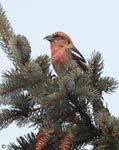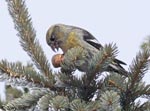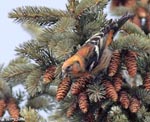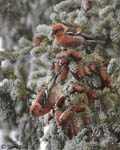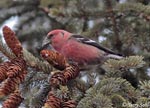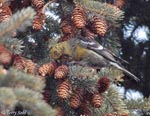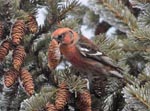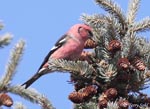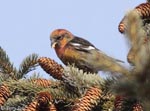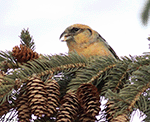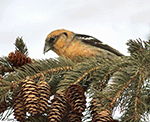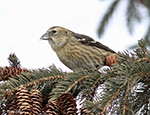| Length: 6.5 inches | Wingspan: 10 inches | Seasonality: Winter |
| ID Keys: Males pink overall, black wings with 2 bold white wing bars, black tail, crossed-bill. Females similar but yellowish overall. | ||
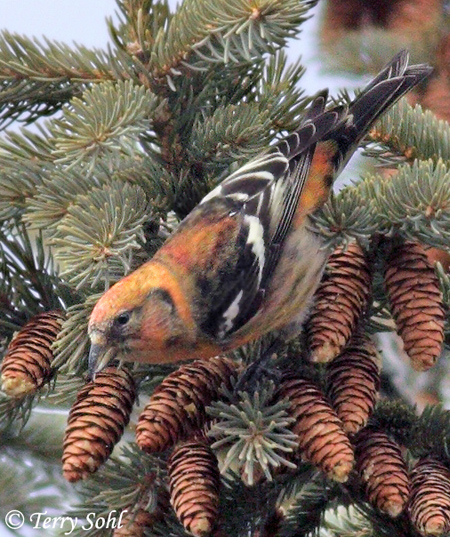 White-winged Crossbills
(often referred to as the "Two-barred Crossbill" in other parts of the world) are true nomads, wandering in large
flocks throughout much of the boreal Northern Hemisphere. While normally
found in Canada and Alaska, in the winter, irregular irruptive migrations may
bring large flocks deep into the continental United States. Their unusual
crossed bills are extremely effective at opening their favorite food item, the
seeds of spruce trees.
White-winged Crossbills
(often referred to as the "Two-barred Crossbill" in other parts of the world) are true nomads, wandering in large
flocks throughout much of the boreal Northern Hemisphere. While normally
found in Canada and Alaska, in the winter, irregular irruptive migrations may
bring large flocks deep into the continental United States. Their unusual
crossed bills are extremely effective at opening their favorite food item, the
seeds of spruce trees.
In South Dakota they are winter visitors, usually found in and around areas with their favored spruce cones. There have been a handful of records in the Black Hills in the summer months, sometimes in groups that consist of several birds. While it is possible they are rare breeders in the Black Hills, to date breeding has not been confirmed.
Habitat:
White-winged Crossbills are nearly always found in conifer forest. Breeding usually occurs in forests with high densities of spruce trees, with spruce trees the preferred host for nesting sites as well.
Diet:
Primarily feeds on spruce seeds if they area available. They will also feed on seeds of other conifers, tree buds, berries, other seeds, and insects.
Breeding:
Breeding has never been confirmed in South Dakota, although there have been a handful of summer observations in the Black Hills. Across their considerable range in both North America and Eurasia, breeding is often irregular and unpredictable. White-winged Crossbills have been confirmed breeding in every month of the year in North America, as breeding often seems to be stimulated by the availability of heavy spruce cone crops. However, they most often breed in the late winter and very early spring.
The nest is most typically built on the branch of a spruce tree. The small cup is constructed by the female, and is built of grasses, twigs, bits of bark, and other vegetative material, lined with finer or softer material such as moss, hair, weed stems, or lichen. The female lays between 2 and 5 eggs, and she alone incubates them. Incubation lasts 12-15 days, with the young fledging from the nest 12 to 18 days after hatching.
Song:
The song of a White-winged Crossbill is a variety of musical chattering and trills given in series. Various calls may be given, most often a fairly rapid peet-peet-peet-peet, sometimes interspersed with single notes with a nasal, honking quality.
1Click here to hear the song of a male White-winged Crossbill
3Click here to hear the typical call of a White-winged Crossbill
Migration:
They can be found in all seasons throughout much of Canada, Alaska, and New England, as well as parts of mountainous western North America. While not strictly migratory, individual flocks will sometimes move great distances in winter in the search for food, and could possibly be found nearly anywhere (in the proper habitat) in the northern half of the U.S. in winter.
In South Dakota, they are overwhelmingly a bird of the winter months, with the vast majority of sightings occurring in winter. However, there are a handful of sightings in the summer months in the Black Hills, a region where their cousins the Red Crossbill is common, found in all season, and is a common breeder. While White-winged Crossbills may be very rare breeders in the Black Hills, breeding has not yet been confirmed.
Interactive eBird Map:
Click here to access an interactive eBird map of White-winged Crossbill sightings
Similar Species:
If seen well, the unique bill of a crossbill is definitive, and the only other species that could potentially be confused with a White-winged Crossbill is the Red Crossbill. Not surprisingly, it's the two bold, obvious white wing bars on a White-winged Crossbill that easily differentiate them from Red crossbills, for both male and female plumages.
Bird Feeders:
White-winged Crossbills usually aren't common at feeders, but they will sometimes attend feeders for sunflower seeds or nyger seed.
South Dakota "Hotspot":
White-winged Crossbills are always very unpredictable winter visitors, and there's no location where sightings can be guaranteed. However, as a species that strongly prefers spruce seeds for feeding, look for similar habitat during the winter months, where they may be (albeit temporarily) attracted to even small stands of spruce trees, depleting the stock of available cone seeds and then moving on.
One place that's surprisingly good to look for White-winged Crossbills in winter...cemeteries! Literally ALL of my sightings (and photographs) of White-winged Crossbills in South Dakota have been at Mount Pleasant Cemetery in Sioux Falls. Old cemeteries such as this often have some very large, very old spruce trees that can hold large crops of spruce cones.
Conservation Status:
It's difficult to monitor overall popoulations of White-winged Crossbills because of their irregular migration habits, but it's thought numbers rise and fall with the availability of conifer seeds. Systematic surveys have recorded declines in the species in recent decades. However, they are still found across an extremely wide geographic area, and are common in parts of that range. The IUCN considers the White-winged Crossbill to be a species of "Least Concern".
Further Information:
1) BirdWeb - White-winged Crossbill
2) WhatBird - White-winged Crossbill.
3) Audubon Guide - White-winged Crossbill
Photo Information:
February 5th, 2012 - Mount Pleasant Cemetery in Sioux Falls, South Dakota - Terry Sohl
Audio file Credits;
1Christopher McPherson. Recorded in Grafton County, New Hampshire on February 22nd, 2020. Original recording and information available on xeno-canto.
2Jarmo Pirhonen. Recorded in King County, Washington on April 29th, 2019. Original recording and information available on xeno-canto.
3Terje Kolaas. Recorded in Traena, Norway on September 14th, 2017. Original recording and information available on xeno-canto.
| Click on the map below for a higher-resolution view |
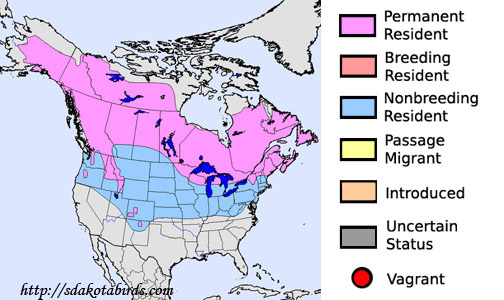 |
| South Dakota Status: Irregular uncommon to rare winter visitor, most common in the northeastern part of the state. There have been a handful of summer sightings in the Black Hills, where their close cousin the Red Crossbill is found in all seasons. |
Additional White-winged Crossbill Photos
Click for a higher-resolution version of these photos
